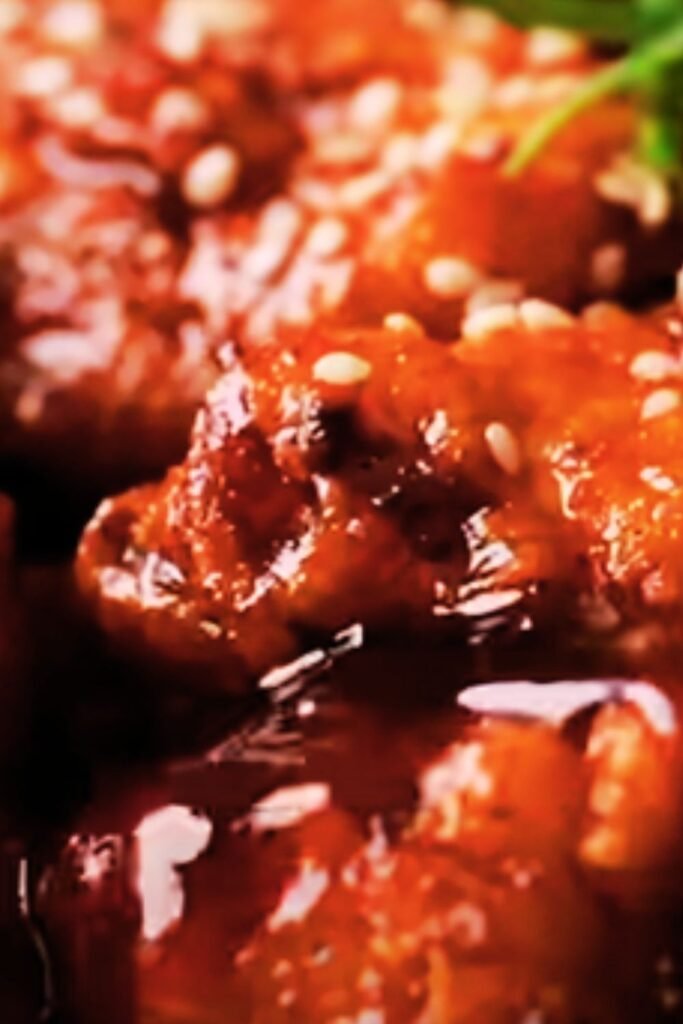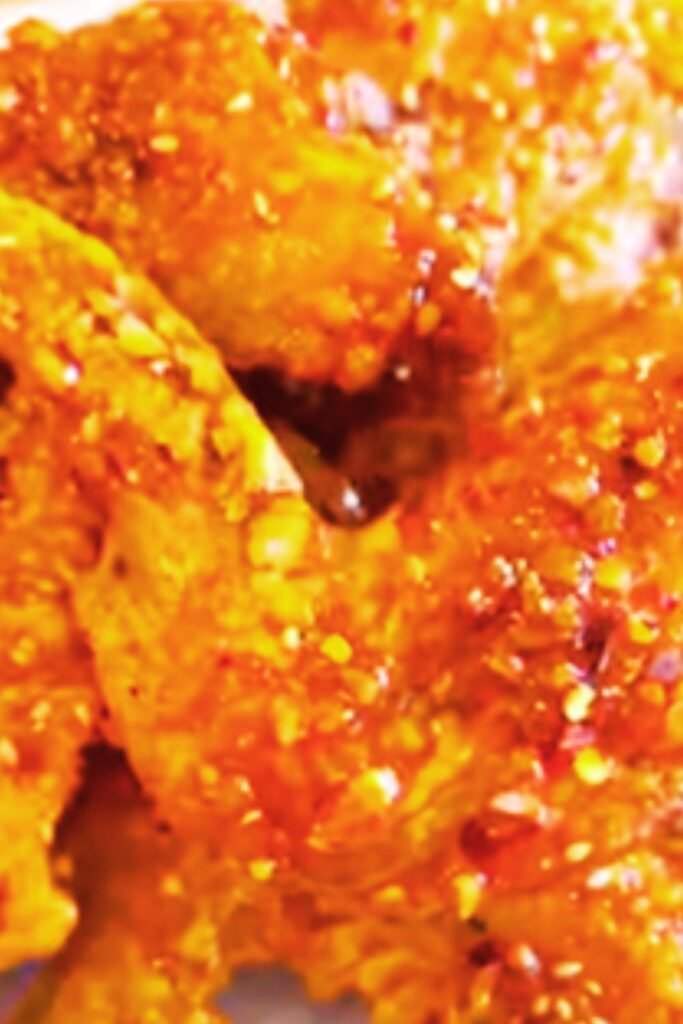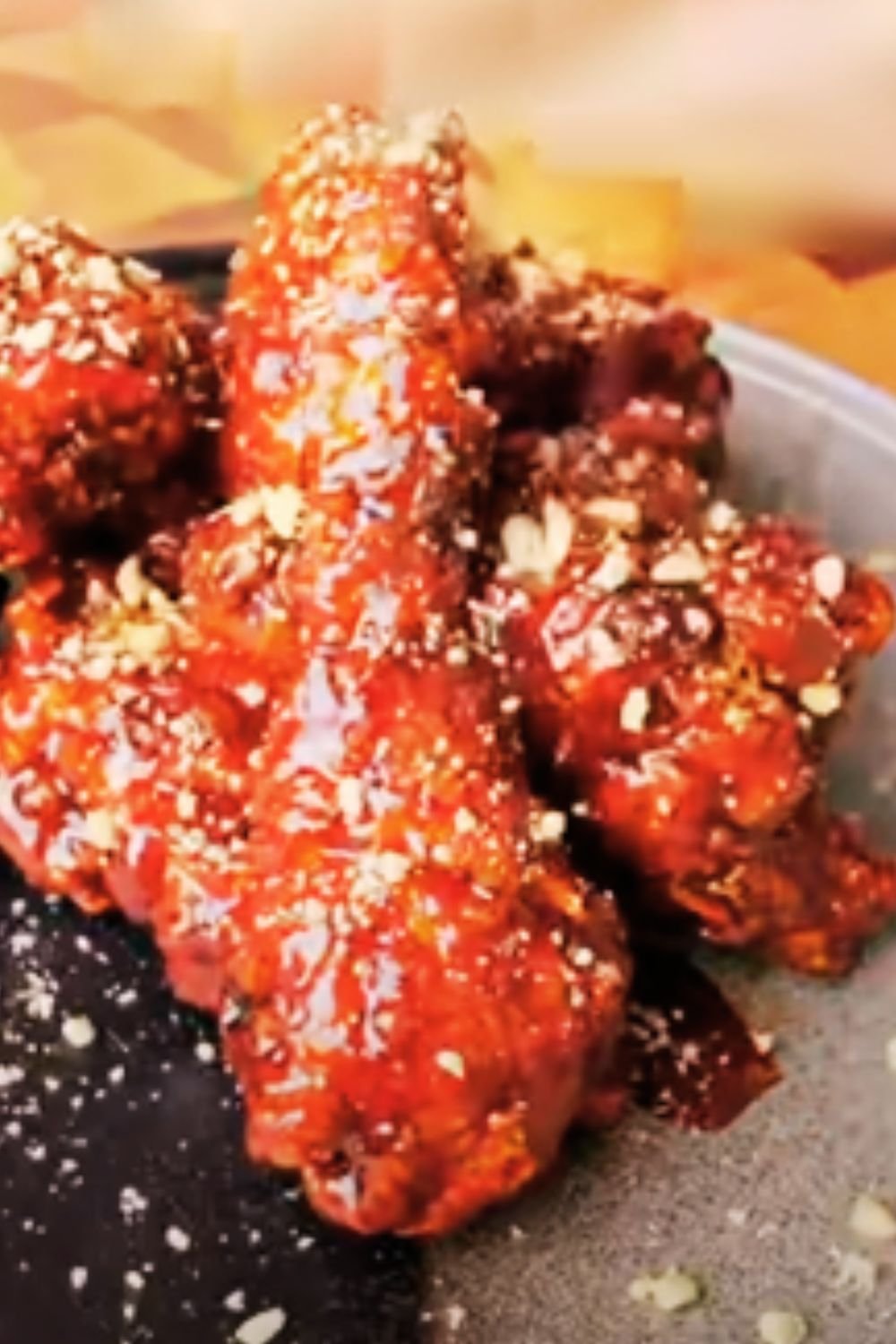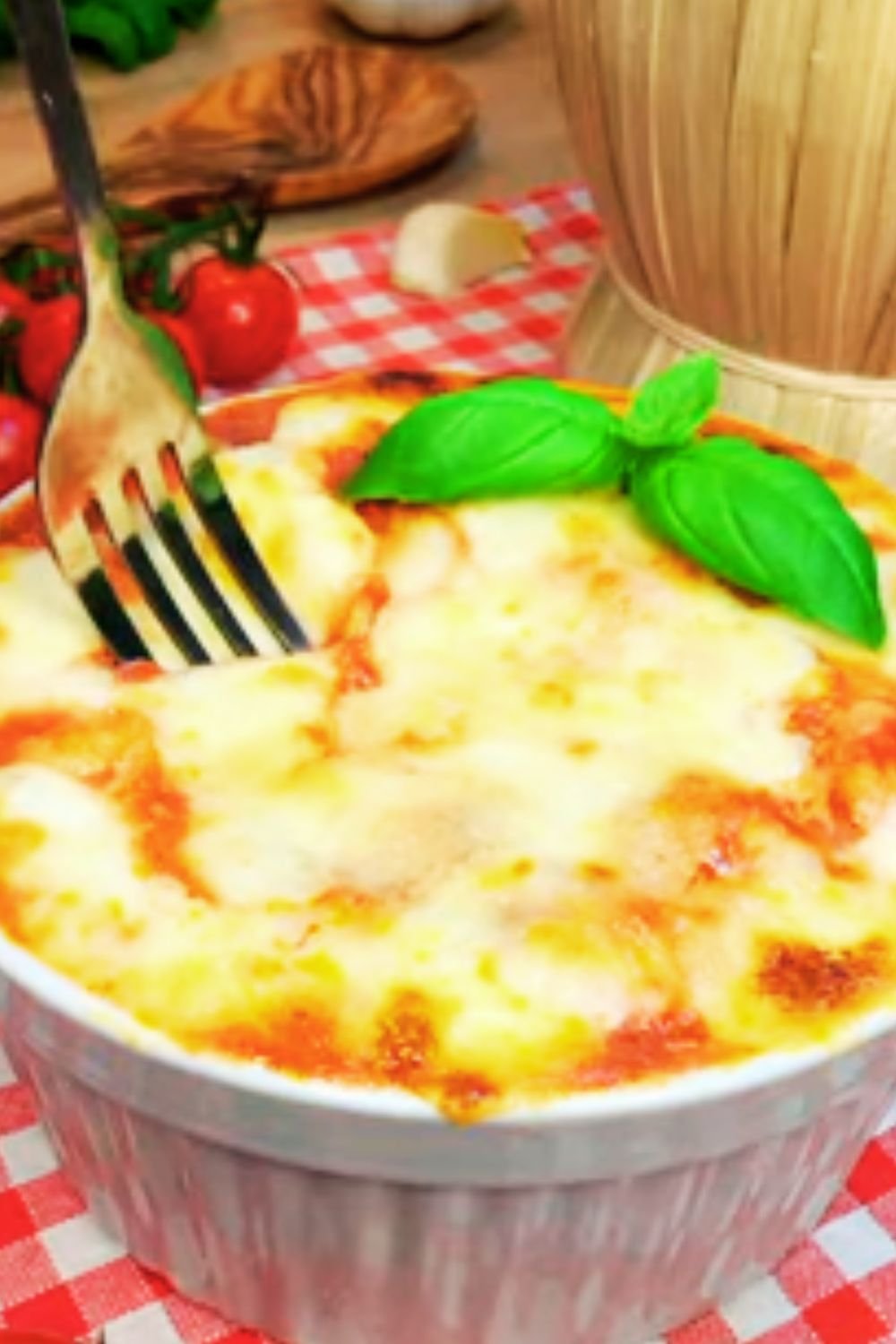There’s something magical about that first bite of Korean fried chicken—the shattering crunch of the paper-thin crust giving way to juicy, tender meat underneath, all coated in a glossy sauce that perfectly balances sweet, spicy, and savory flavors. I’ve spent years perfecting my Korean fried chicken recipe, and I’m thrilled to share everything I’ve learned with you today.
What Makes Korean Fried Chicken Special?
Korean fried chicken, often affectionately called “KFC” (Korean Fried Chicken) by enthusiasts, has taken the culinary world by storm—and for good reason. Unlike its American counterpart, Korean fried chicken boasts several distinctive characteristics that set it apart:
- Double-frying technique: This creates an exceptionally crispy exterior that stays crunchy even when coated in sauce
- Thin, shatteringly crisp crust: Achieved through specific battering methods and ingredients
- Unique glazes and sauces: From garlicky soy to sweet and spicy gochujang-based coatings
- Smaller pieces: Typically cut into smaller, more manageable pieces with bones in
- Accompaniments: Served with pickled radish, beer, or soju rather than mashed potatoes and gravy
The result is an incredible textural and flavor experience that’s completely different from other fried chicken styles you might have tried before.
The History Behind Korean Fried Chicken
Korean fried chicken has a fascinating history that’s more recent than you might expect. While various forms of fried chicken have existed in Korean cuisine for centuries, the modern version we know today emerged in the 1970s and 1980s.
Following the Korean War, American military presence introduced Western-style fried chicken to South Korea. However, it wasn’t until the late 1970s when enterprising Korean chefs began to modify and perfect the technique, creating something uniquely Korean.
The first Korean fried chicken franchise, Lim’s Chicken, opened in 1977, but the style truly exploded in popularity during the 1980s with the rise of chains like Kyochon and Pelicana. The Asian financial crisis of the late 1990s actually helped fuel the growth of the industry, as many laid-off workers opened chicken restaurants as a means of self-employment.
Today, Korean fried chicken is a global phenomenon, with dedicated restaurants in major cities worldwide. It’s become a cultural touchstone in Korea, where it’s commonly enjoyed while watching sports events and is a popular delivery food—often paired with beer in a combination affectionately called “chimaek” (chicken + maekju, the Korean word for beer).
Essential Ingredients for Authentic Korean Fried Chicken
Before we dive into the cooking process, let’s review the key ingredients that give Korean fried chicken its distinctive flavor and texture:
| Ingredient | Role | Substitution Options |
|---|---|---|
| Chicken | Primary protein, traditionally wings and drumsticks | Boneless thighs or breast pieces work well too |
| Potato starch | Creates the signature crispiness | Corn starch (slightly different texture) |
| Rice flour | Helps achieve thin, crispy coating | All-purpose flour (though less crispy) |
| Baking powder | Helps create airy, crisp texture | No direct substitute |
| Gochujang | Spicy pepper paste for sauce | Sriracha mixed with miso (different flavor profile) |
| Gochugaru | Korean chili flakes | Red pepper flakes (less complex flavor) |
| Garlic | Essential flavor component | Garlic powder (less aromatic) |
| Ginger | Adds aromatic warmth | Ginger powder (less bright flavor) |
| Soy sauce | Umami foundation for sauces | Tamari or coconut aminos |
| Rice vinegar | Adds brightness to sauces | Apple cider vinegar (slightly different flavor) |
| Honey or brown sugar | Sweetness and glaze | Maple syrup or agave nectar |
| Toasted sesame oil | Distinctive nutty finish | No true substitute |
| Sesame seeds | Garnish and texture | Skip if unavailable |
The combination of starches is particularly important—this is what creates the paper-thin, shatteringly crisp coating that distinguishes Korean fried chicken from other varieties.

The Double-Frying Technique Explained
The hallmark of Korean fried chicken is the double-frying method, which is essential for achieving that perfect crunch that stays crispy even when sauced. Here’s why it works:
The first fry (at a lower temperature of around 325°F/165°C) cooks the chicken through while beginning to set the crust. During this stage, moisture from the chicken creates steam that pushes outward through the coating. When you remove the chicken and let it rest, this moisture has a chance to evaporate from the surface.
The second fry (at a higher temperature of around 375°F/190°C) is shorter and dehydrates the exterior completely, creating that signature crispy shell. This two-step process ensures that the crust doesn’t absorb the sauce and become soggy.
I’ve tested many variations of this technique, and I’ve found that allowing at least a 5-minute rest between fries is crucial for the best texture. During this rest period, the chicken continues to cook slightly from residual heat while the exterior begins to dry, setting you up for maximum crispiness during the second fry.
My Foolproof Korean Fried Chicken Recipe
Now let’s get to the main event—the recipe itself! This recipe makes enough for 4-6 people as an appetizer or 2-3 as a main dish.
Ingredients
For the chicken:
- 2 lbs (900g) chicken wings and drumsticks
- 1 teaspoon salt
- ½ teaspoon black pepper
- ½ teaspoon garlic powder
- 1 tablespoon rice wine (optional)
- 1 egg white
- ½ cup potato starch
- ¼ cup rice flour
- 2 tablespoons cornstarch
- ½ teaspoon baking powder
- Vegetable or peanut oil for frying
For the soy garlic sauce (yangnyeom):
- 3 tablespoons soy sauce
- 3 tablespoons brown sugar or honey
- 2 tablespoons minced garlic
- 1 tablespoon rice vinegar
- 1 tablespoon gochugaru (Korean chili flakes)
- 1 teaspoon grated ginger
- 2 tablespoons water
- 1 tablespoon toasted sesame oil
- Sesame seeds and sliced green onions for garnish
For the spicy gochujang sauce:
- 2 tablespoons gochujang (Korean chili paste)
- 2 tablespoons honey or brown sugar
- 1 tablespoon soy sauce
- 1 tablespoon minced garlic
- 1 teaspoon rice vinegar
- 1 tablespoon ketchup
- 1 tablespoon toasted sesame oil
- Sesame seeds for garnish
Preparation Steps
- Prepare the chicken: Pat the chicken pieces dry with paper towels. This is crucial for achieving crispy skin. Season with salt, pepper, and garlic powder. Add rice wine and egg white, mixing thoroughly. Let marinate for at least 30 minutes (or up to overnight in the refrigerator).
- Make the coating: In a large bowl, mix potato starch, rice flour, cornstarch, and baking powder. The combination of starches creates the perfect crispy texture.
- Heat the oil: Fill a large heavy-bottomed pot with about 2 inches of oil. Heat to 325°F (165°C). Use a thermometer for accuracy—temperature control is essential for perfect Korean fried chicken.
- First fry: Coat the chicken pieces in the starch mixture, shaking off excess. Fry in batches for 5-6 minutes, until lightly golden but not browned. Don’t overcrowd the pot. Remove and drain on a wire rack. Let rest for 5-10 minutes.
- Second fry: Increase oil temperature to 375°F (190°C). Fry the chicken again in batches for 2-3 minutes until deeply golden and very crispy. Drain on a wire rack.
- Prepare the sauces: While the chicken is resting between fries, make your sauces. For soy garlic sauce: Combine soy sauce, brown sugar, garlic, rice vinegar, gochugaru, ginger, and water in a small saucepan. Bring to a simmer over medium heat and cook until slightly thickened, about 3-4 minutes. Remove from heat and stir in sesame oil. For spicy gochujang sauce: Mix all ingredients in a bowl until well combined. For a smoother sauce, you can heat gently in a saucepan.
- Coat the chicken: Toss hot fried chicken in your sauce of choice, or serve sauce on the side for dipping. Garnish with sesame seeds and sliced green onions.
- Serve immediately: Korean fried chicken is best enjoyed hot and fresh while the contrast between crispy exterior and juicy interior is at its peak.

Pro Tips From My Kitchen to Yours
After making countless batches of Korean fried chicken, I’ve collected some invaluable tips that will help you achieve restaurant-quality results:
- Temperature control is critical: Use a thermometer to maintain proper oil temperature. Too low, and your chicken will be greasy; too high, and the exterior will burn before the interior cooks.
- Don’t skip the resting period: The rest between fries is not optional! This crucial step allows moisture to escape from the crust, ensuring maximum crispiness.
- Use potato starch: While you can substitute cornstarch, potato starch creates a distinctly lighter, crispier texture that’s characteristic of authentic Korean fried chicken.
- Fry in small batches: Overcrowding the pot lowers the oil temperature too much and leads to soggy chicken.
- Drain properly: Always drain on a wire rack rather than paper towels, which can create steam and soften the crust.
- Sauce at the right moment: If using sauce, toss the chicken immediately before serving. The longer the sauce sits on the chicken, the more it will soften the crust.
- Make extra sauce: These sauces are addictive and great for dipping other foods too!
- Consider boneless options: For easier eating, especially at parties, boneless chicken thighs cut into bite-sized pieces work wonderfully.
Common Mistakes to Avoid
Even with a great recipe, there are pitfalls that can affect your Korean fried chicken results. Here are the most common mistakes to avoid:
| Mistake | Consequence | How to Avoid |
|---|---|---|
| Chicken not dry enough | Soggy, not crispy coating | Pat chicken thoroughly with paper towels before coating |
| Oil temperature too low | Greasy, oily chicken | Use a thermometer and maintain proper temperatures |
| Overcrowded frying pot | Uneven cooking, temperature drops | Fry in small batches, giving pieces plenty of room |
| Skipping the double-fry | Less crispy result | Follow the two-stage frying process |
| Too thick coating | Heavy, bready texture instead of light crispiness | Shake off excess coating before frying |
| Adding sauce too early | Soggy crust | Toss in sauce just before serving |
| Using old oil | Off flavors | Use fresh oil or filter and reuse only once |
| Improper draining | Soggy bottom pieces | Use a wire rack instead of paper towels |
Traditional Accompaniments
In Korea, fried chicken is rarely served alone. Here are the traditional accompaniments that complete the experience:
- Pickled radish (chicken-mu): These yellow cubes of pickled daikon radish provide a refreshing, tangy counterpoint to the rich chicken.
- Sliced raw vegetables: Cucumber, carrot, and bell pepper sticks offer freshness and crunch.
- Rice: A bowl of steamed white rice balances the meal.
- Kimchi: The fermented vegetable side dish adds complexity and probiotic benefits.
- Non-alcoholic options: Barley tea (boricha) or a citrus soda like Chilsung Cider are popular choices.
For a complete Korean fried chicken experience, I always prepare at least the pickled radish, which is simple to make at home by marinating daikon radish cubes in a mixture of vinegar, sugar, and water for at least 2 hours.
Regional Variations
Korean fried chicken isn’t a monolith—there are interesting regional variations across South Korea:
- Seoul-style: Typically focuses on classic soy garlic or spicy gochujang sauces, with a very thin, crispy crust.
- Busan-style: Often incorporates seafood flavors or comes with seafood on the side, reflecting the city’s coastal location.
- Gangwon-style: May include mountain herbs or pine nut flavors from this forested region.
- Fusion variations: Modern innovations include flavors like green onion, cheese powder, or sweet and sour.
Some restaurants even specialize in “ban-ban” chicken, serving half with one sauce and half with another so you can enjoy multiple flavors in one meal.

Serving Suggestions
Korean fried chicken makes for an excellent:
- Party food: Cut wings into drummettes and flats, and serve with multiple sauces for variety.
- Main dish: Pair with rice, kimchi, and a light soup for a complete meal.
- Late-night snack: Enjoyed the way many Koreans do, as a late evening indulgence.
- Game day treat: Perfect for sports watching with its finger-food nature and bold flavors.
For a full Korean spread, consider adding:
- Kimchi fried rice
- Japchae (sweet potato noodles with vegetables)
- Pajeon (scallion pancakes)
- Banchan (small side dishes)
- Doenjang jjigae (soybean paste stew)
Healthier Adaptations
While traditional twice-fried chicken is undeniably delicious, here are some modifications if you’re looking for a somewhat healthier version:
- Air fryer method: Spray chicken pieces with oil and air fry at 380°F for 10 minutes, flip, and cook for another 8-10 minutes until crispy. Repeat at 400°F for 3-4 minutes for the “second fry” effect.
- Oven-baked version: Coat chicken with a little oil after dredging in the starch mixture, then bake at 425°F on a wire rack over a baking sheet. Bake for 30 minutes, flip, and bake for another 15-20 minutes until crispy.
- Skinless option: Remove the skin from chicken pieces to reduce fat content (though you’ll sacrifice some crispiness).
- Sauce modifications: Reduce sugar in sauces and use natural sweeteners like pureéd fruit or a smaller amount of honey.
While these adaptations won’t perfectly replicate the traditional twice-fried experience, they can still deliver delicious results with lower fat content.
My Journey with Korean Fried Chicken
I first encountered Korean fried chicken during a visit to Seoul’s Myeongdong district, where the intoxicating aroma of frying chicken and garlicky sauce drew me into a tiny restaurant packed with locals. That first bite—impossibly crunchy yet juicy, sweet yet spicy—was a revelation that sent me on a years-long quest to recreate that magic at home.
Through countless test batches, adjustments, and even a cooking class with a Korean chef, I’ve refined this recipe to capture that authentic taste and texture. The double-frying technique was particularly challenging to master—finding exactly the right temperatures and timing took dozens of attempts.
What keeps me coming back to this dish is not just the incredible flavor but the joy it brings to anyone I serve it to. There’s something universally appealing about perfect fried chicken, and the Korean approach elevates it to an art form.
Questions & Answers
Q: Can I make Korean fried chicken in advance?
While Korean fried chicken is best eaten immediately after cooking, you can prepare components ahead of time. Marinate the chicken up to 24 hours in advance, and make your sauces a day ahead. If needed, you can do the first fry earlier in the day, then complete the second fry just before serving. For leftovers, reheat in a 375°F oven on a wire rack until crispy again—never use the microwave, which will make the chicken soggy.
Q: Is Korean fried chicken gluten-free?
Traditional Korean fried chicken is not gluten-free due to the soy sauce in the marinades and sauces. However, you can easily make it gluten-free by substituting tamari or coconut aminos for soy sauce. The potato starch and rice flour coating is naturally gluten-free, making this an easy adaptation.
Q: How spicy is authentic Korean fried chicken?
The spice level of Korean fried chicken varies widely! Soy garlic varieties are mild with no significant heat, while gochujang-based sauces can range from moderately spicy to quite hot. The good news is you can easily adjust the spice level by controlling the amount of gochugaru (Korean chili flakes) and gochujang (chili paste) in your sauces.
Q: What’s the best oil for frying Korean chicken?
Neutral oils with high smoke points work best. Vegetable, canola, peanut, or rice bran oil are all excellent choices. In Korea, many restaurants use vegetable or soybean oil. Avoid olive oil or other strongly flavored oils, as they’ll compete with the chicken’s flavors and often have lower smoke points.
Q: Can I reuse the oil after frying?
Yes, with proper handling. After frying, let the oil cool completely, then strain through a fine-mesh strainer lined with cheesecloth to remove all food particles. Store in an airtight container away from light and heat. You can generally reuse it once more for frying chicken, then perhaps once more for something less delicate. Discard oil that smells rancid or has darkened significantly.
Q: Why does my coating keep falling off the chicken?
This usually happens when the chicken has too much moisture on the surface or when the oil isn’t hot enough. Make sure to thoroughly pat the chicken dry before coating it, and verify your oil temperature with a thermometer. Another tip: let the coated chicken sit for 5-10 minutes before frying, which helps the coating adhere better.
Q: What can I substitute for potato starch?
While potato starch creates the ideal texture, cornstarch is the best substitute. You’ll still get a crispy coating, though it might be slightly heavier. You can also try a 50/50 mix of cornstarch and rice flour if potato starch is unavailable.
Q: How do Korean restaurants keep their chicken crispy for delivery?
Korean chicken restaurants use specialized ventilated containers that prevent steam from softening the chicken. At home, you can approximate this by avoiding closed containers. If you must transport the chicken, use a paper bag lined with parchment paper rather than a sealed plastic container, and carry sauces separately to add just before eating.
Conclusion
Korean fried chicken represents the perfect intersection of technique and flavor—a dish where careful preparation meets bold seasonings to create something greater than the sum of its parts. The double-frying method may require a bit more time and attention, but the results are undeniably worth it: chicken with a shatteringly crisp exterior, juicy interior, and complex flavors that keep you coming back for just one more piece.
Whether you’re making it for a special occasion, game day, or simply because you deserve a treat, this recipe will help you achieve authentic Korean fried chicken at home. The combination of that perfect crunch and the sweet-spicy-savory glaze makes this dish completely irresistible.
I hope you enjoy making and eating this Korean fried chicken as much as I do. Once you’ve mastered the basic technique, don’t be afraid to experiment with different sauce variations and accompaniments to make this recipe your own!


